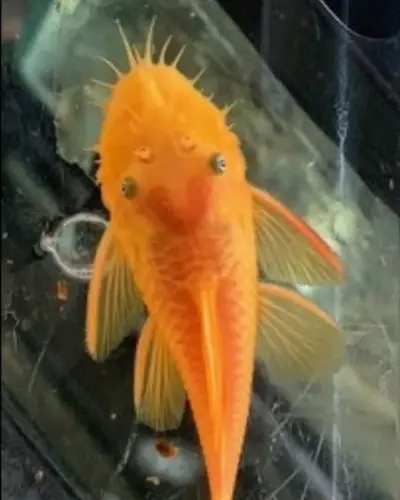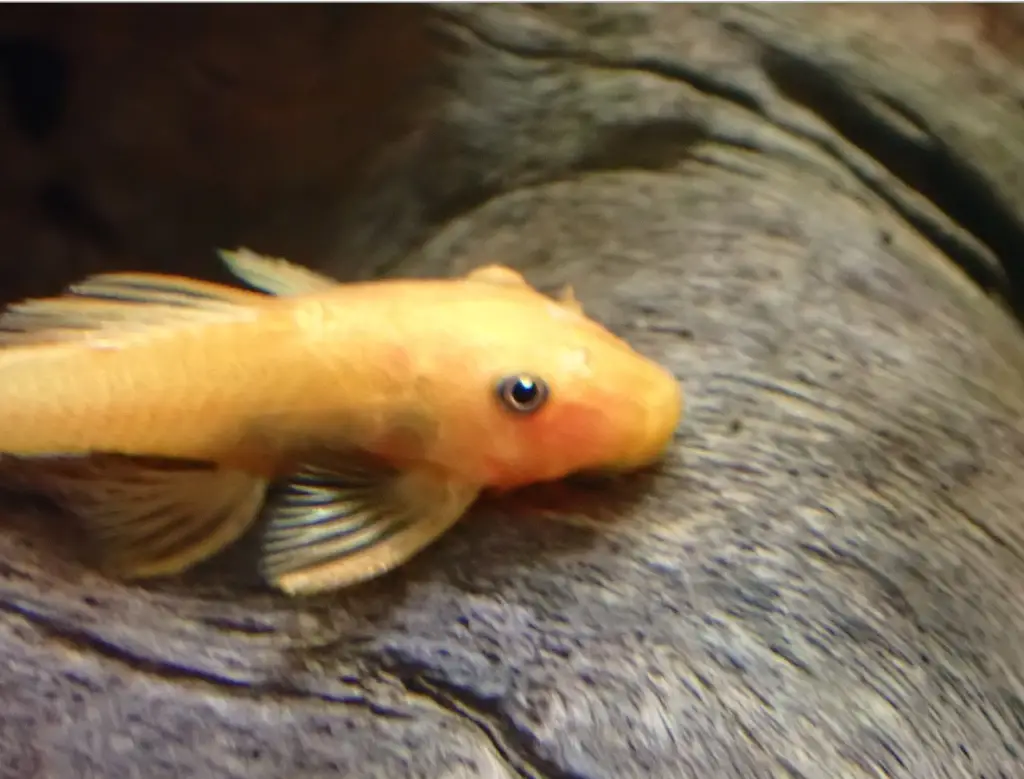Are you searching for a unique and captivating addition to your aquarium? Look no further than the Super Red Bristlenose Pleco for sale, a stunning freshwater species that effortlessly combines beauty and functionality.
Known for their vibrant red hues and charming whisker-like bristles, these plecos are not just eye-catching but also exceptional algae eaters, making them a favorite among aquarists.
Imagine your tank adorned with a bold splash of red, while these peaceful fish help maintain a clean and balanced environment.
Whether you’re an experienced hobbyist or just beginning your journey in the aquatic world, the longfin Super Red Bristlenose Pleco offers both aesthetic appeal and practical benefits.

In this blog post, we’ll dive into everything you need to know about these incredible Super Red Bristlenose Pleco creatures, including their care requirements, tank setup tips, and where to find healthy specimens.
Ready to make your aquarium stand out? Let’s explore why the super red longfin bristlenose pleco is the ideal choice for your tank!
Table of Contents
ToggleIs Super Red Bristlenose a Pleco?
What is a super red Bristlenose Pleco? A super red bristle nose pleco is a specific strain of the common red or orange plecostomus (L66) and can be identified by its orange-reddish color and bristly head growth.

These freshwater fish are native to the united states of South America, where they inhabit rivers and streams. They grow to around 6 inches long, making them an excellent fit for medium to large aquariums.
What Type of Environment Do Red Plecos Need?
Super Red Plecos need a warm, clean, and well-oxygenated environment with plenty of hiding places. The ideal temperature range should be between 74°F and 84°F (23.5 to 28.5°C).
Aquariums should have a fine gravel substrate, driftwood, and rocks or caves for hiding places. Live plants also provide additional oxygenation and food sources for the bushynose or bushymouth Pleco.
How Big Do Super Red Bristlenose Plecos Get?
Super red Bristlenose Pleco size is typically around 6 inches (15 cm) in length, although some have been known to reach up to 8 inches (20 cm). Females tend to be slightly smaller than males.
Bristlenose Plecos, also known as Ancistrus dolichopterus, typically grow to reach up to 5-6 inches in length at adulthood. The lifespan is usually between 4-8 years, and they can weigh anywhere from 2-4 ounces when fully grown.
Are Super Red Plecos Aggressive?
Super Red Plecos are generally non-aggressive fish; however, they will become territorial when housed in an overcrowded tank or with other species of the same type.
These fish are generally peaceful and do not cause trouble to their tankmates unless threatened. Super Red Plecos can make great additions to any aquarium when given enough space and a balanced diet.
What Do Super Red Bristlenose Plecos Eat?
They are omnivorous and enjoy a variety of foods such as algae wafers, frozen foods or live foods, green beans, fresh vegetables, and more. Super Red bushynose plecos are primarily herbivorous and should be given a varied diet rich in vegetable matter, such as cucumber, blanched spinach, and spirulina.
In addition to the fresh veggies, they will also consume some proteins and invertebrates. If given the opportunity, they may nibble on live plants, so it is essential to ensure they are well-fed with adequate greens like cucumbers and zucchini.
What Tank Mates Are Compatible With Super Red Bristlenose Plecos?
Super red Bristlenose Plecos are peaceful and can be kept with many other tank mates. As long as the tank is large enough, they can be kept with most species of cichlids and tetras. Other compatible tank mates include Corydoras, Odessa barbs, and other small catfish.
It is essential to remember that their tank mates should not be overly aggressive as the Super Red Bristlenose Ancistrus sp Plecos can become stressed out quickly. It is also best to avoid keeping them with large fish like Oscars that may try to eat them.
How Much Are Super Red Pleco “Ancistrus sp“? (Super Red Bristlenose Pleco Price)
Longfin super red bristlenose pleco for sale costs can vary depending on the size great, shape, age, and origin of the fish. Generally, one live fish should expect to pay around $15-20 for a juvenile or adult fish. However, prices can range from as low as $10 up to $50 for rare specimens.
Red Ancistrus sp Plecos are relatively inexpensive fish and make great additions to any freshwater aquarium due to their peaceful temperament and attractive appearance.
They are an excellent choice for both beginner and experienced hobbyists alike. With the proper care, these fish can live up to 8 years or more. A healthy fish, well-cared-for Super Red Bristlenose Pleco Ancistrus sp will be a reliable part of your aquarium for many years.
What Size Tank for Super Red Bristlenose?
Super Red Ancistrus sp Plecos need at least a 30-gallon tank. This is because these fish are active and get quite large, ancistrus pleco size reaching up to 7 inches.
The Super Red Bristlenose Pleco tank size should provide plenty of space for them to explore and interact with their environment, with ample hiding places that will help them feel secure.
Additionally, the increased water volume helps keep nitrates lower than if the same number of plecos were housed in a smaller community aquarium.
Proper filtration should also keep the water clean and livable for your fish. Providing plenty of surfaces for algae growth is also beneficial for keeping your bristlenose pleco ancistrus sp happy and healthy.
How Long Do Super Red Bristlenose Plecos Live?
The average super red bristlenose pleco lifespan is at least five years. These hardy fish are known to be exceptionally long-lived and can sometimes exceed ten or even fifteen years in captivity with proper care and maintenance.
They are considered one of the longest-living aquarium fish species, which makes them an excellent choice for those looking to build a thriving community tank.
With proper care, these fish will remain active and vibrant companions in your aquarium for many years. They are also excellent choices for beginner hobbyists as they require minimal maintenance and are relatively hardy.
Super Red Bristlenose Pleco Care
Many people are interested in keeping Ancistrus sp Plecos but don’t know how to care for them properly.
If you’re not careful, you can quickly kill your bristlenose pleco ancistrus sp by making one of these common mistakes.
Watch this video and learn how to care for your Super Red Pleco like a pro. We’ll show you the right food to feed them, the best way to keep their tank clean, and how often you should change the water.
Super Red Bristlenose Pleco Breeding Pair
Super Red Plecos are some of the most popular aquarium fish due to their beautiful red-orange coloration and peaceful temperament. When it comes to breeding pairs, you want to make sure that both fish are equally healthy and compatible with one another.
Generally, you can purchase two juvenile Super Reds approximately the same size. Hence, they have an equal chance of establishing a pecking order within the tank.
It would help if you also kept an eye on your new Super Reds to monitor any aggression between them. If they start nipping or fighting each other, re-homing one might be necessary as it could cause harm to either or both fish in the long run.
It’s important not to overcrowd your tank when housing a breeding pair, as this can also lead to aggressive behavior.
Once you have established a stable environment for your Super Reds, ensure that plenty of other hiding spots and spaces with caves and rocks are available for them, increasing their comfort levels and encouraging breeding activity!
Super Red Bristlenose Pleco Temperature:
Super red Bristlenose pleco water parameters should mimic their natural environment, typically warm tropical freshwater. Generally, the water temperature should range between 72-86°F (22-30°C).
It would help to strive for a neutral pH of 6.5-7.5 and an ideal hardness of 4-12 dGH. If you have increased levels of nitrate or ammonia, frequent water changes and filter maintenance may be necessary to keep your super red longfin bristlenose pleco healthy.
Monitoring the water temperature regularly is also essential, as any drastic changes can cause stress to your fish.
How to Tell the Difference Between Male and Female Super Red Bristlenose Pleco?
Super red Bristlenose Pleco male and female fish can be difficult to differentiate as juveniles. However, as the fish mature, some key differences can help you identify each gender.
Generally, males tend to have a thicker head shape and longer bristles around their mouths than females. Male plecos Super Reds also have more enormous tentacles on their heads and tend to be more vibrant in color.
Conversely, females are generally smaller, have shorter bristles, and have less vibrant coloration than males.
Additionally, it’s important to note that during the breeding season, when the female is full of eggs, her abdomen will appear rounder than expected and even less active than usual.
With proper care and a healthy environment, Super Red Plecos can make excellent, active and vibrant companions in your aquarium for many years.
FAQs
How big do longfin albino Bristlenose plecos get?
Longfin albino Bristlenose pleco fish species typically grow up to 4-5 inches in length. Provide adequate tank space and a balanced diet for their health and well-being.
What is the full size bristlenose pleco?
The full size of a Bristlenose pleco typically reaches around 4-6 inches in length, making them suitable for many aquarium setups due to their manageable size.
How big do green dragon bristlenose plecos get?
Green dragon bristlenose plecos ( Ancistrus sp. ) reach a maximum size of around 5-6 inches (12-15 cm) in length.
Conclusion
If you’re looking for an exciting aquarium companion, look no further than the longfin Super Red Bristlenose Plecos. With their beautiful colors and fascinating personality, these fish make a great addition to any tank. Their tolerance to a wide range of water conditions makes them even more desirable! However, it would help if you remembered that it is necessary to keep their home clean as they are somewhat fragile fish that do not take well to stress or overcrowding.
Feed the bristlenose pleco red fish various live and prepared foods to maintain their health and coloration. But most importantly, don’t forget to enjoy your time with this unique species by watching them playing in the tank. For those passionate about aqua scaping, whether experienced or just starting, the Super Red Bristlenose Pleco can be a stunning feature in your aquarium if given the proper care and habitats – so don’t hesitate to explore this majestic Pleco today!
You might also like
- How to Stop Cory Catfish from Breeding? (A Definitive Guide)
- How to Fix Swim Bladder in Cory Catfish? (Solved & Explained)
- Can Different Cory Catfish Breed! – (Is It Even Possible??)
- What Is the Best Substrate for Corydoras? Tank Setup Guide
- Why Do Cory Catfish Swim to the Top? (7 Causes & Solutions)
- Ultimate Rubber Lip Pleco Care Guide: Price, Size & More
- Bristlenose Catfish Size: A Comprehensive Beginners Guide!
- Plecos Bristlenose Species Profile: (A Comprehensive Guide)
- Bristlenose Catfish Lifespan: 12 Years?! Shocking Truth!




